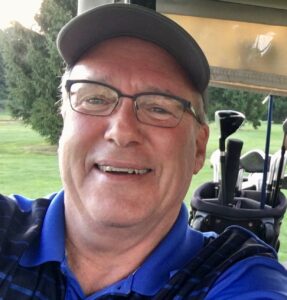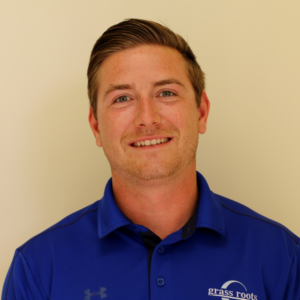A surprise dry spell and heat wave around the northern U.S. meant an early start to water management for many courses. We talked with turf pros in hard-hit areas in the northeast who met the challenge using Zipline.
As you may have noticed, much of the U.S. seemed to skip spring and go directly to summer this past April and May. Little precipitation and higher-than-average temps combined to instantly dry down courses to mid-summer conditions. Turf teams were hand-watering before Easter. Not good.
Around the northeast, superintendents jumped into water management mode 6 weeks earlier than usual. And, more than ever, they turned to Zipline as their wetting agent tool of choice.
What’s the attraction? Tom Valentine of Aquatrols puts it succinctly: “Zipline has grown exponentially over the last three years because the surfactant component and plant health component have created a 1+1= 3 scenario.”
What does that mean in the real world under awful conditions? I decided to ask savvy supers and sales folks around in the hard-hit mid-Atlantic area to find out more about how Zipline gave them what they needed just when they needed it.
Distributor sees the big picture.
Few folks have a better perspective on the region than Keith Kubik, the second-generation owner of Grass Roots, Inc., one of America’s best turf distributors. He gets feedback from his team from around New Jersey and Pennsylvania.
Currently, he’s seeing more and more customers convert to Zipline in general, but the dry spell was a wake-up call for many. “It’s a wetting agent year. It’s so bad that we actually appreciated the heavy smoke from the Canadian forest fires because they lowered ET rates for a few days,” he says.
“What we like about Zipline is the flexibility in application,” says Kubik. “You can water it in with .15”on or really flood it into the rootzone…whatever your preference…but we kind of like the idea of putting down a little less water up front and letting your normal watering practices drive it down.”
Having a choice is huge. “That flexibility with tank mix partners has been fantastic because without having to water in behind it you can throw other products in with it. It’s been easy to fit into a lot of programs.”
One of his customers who had not been a fan or wetting agents is now “one of my better salesmen” after trying Zipline. “It’s such a flexible product no matter what your soil type or spray schedule might be,” he says. “We’ve had no complaints and the feedback has been ‘send me more.’”
He adds: “Many customers normally didn’t start using wetting agents until at least Memorial Day. Now they started a month early and they’re embracing it (Zipline) because they don’t have time to water in or slide in an extra app. For them, this is now a new tank mix partner that allows them to get more done in a limited amount of time.”
And it’s more than just the compatibility and flexibility: “With cooler soils coming out of spring, guys are seeing a response at a time when they normally wouldn’t get from a wetter agent. I think it’s that little response from AquaVita. It’s a turf color response they don’t normally see. It’s a reminder there’s that technology there that definitely adds to Zipline.”
Overcoming Fear of “Frankenstein”
Brett Blackwood is super at Black Hawk GC in Aliquippa, Penn., and is – get ready for this – a 5th-generation superintendent at his family’s beloved and busy facility.
The facility will celebrate its centennial in 2027 and still features original push-up greens. Blackwood is short-staffed (a crew of 10 for 36 holes) and has an irrigation system he describes as a Frankenstein mash-up contraption that needs a lot of care to keep running. “My dad and I are probably the only ones on the planet who could operate it,” he laughs. “It’s a bit of a nightmare.”

So wetting agent apps weren’t usually part of the equation because it was often chancy whether the system would allow them to water the products in. That felt risky, yet he knew he needed help during the 2023 dry spell. Based on recommendations from colleagues, decided to try Zipline. “We went out with Zipline in early June and, predictably, we struggled to get water down.”
It ended up being close to 48 hours before they were able to get water on much of the course. “My anxiety was sky-high thinking everything would be locked up in the top couple of inches of the soil profile. Instead, I didn’t see any issues.” Blackwood said he saw an immediate green-up and cups were easier to cut. The color and dew on the greens were all the signs that Zipline was working perfectly and moisture was being held.
“It was clearly effective but having that flexibility about watering in was great,” he says. “That peace of mind was huge.”
Blackwood has changed his tune about wetting agents. “What I’d heard through the grapevine was really an understatement. This was the perfect trial by fire and Zipline passed the test. Zipline will be our product until something else comes along that’s clearly better.”
“Honestly, everybody loves it”
Keith Perl has seen a lot of changes over a few decades in turf distribution in Pennsylvania, but the head of Walker Supply loved one product more than most. “Revolution really was a revolution when it arrived, but we had to retrain people to soak it down through the profile. Once people understood that, they saw how phenomenal it was and how much it eliminated LDS and hand watering. But the need to water it in was a limiting factor for some customers.”
Perl is a believer and says the majority of his customers have converted to Zipline. “Honestly, everybody loves it.”
The spring heat and drought was a proving ground for many, according to Perl. Customers told him how well the Zipline treated areas held up during the extended dry patch and then how quickly it popped back when the rain came.
Perl notes he still has plenty of customers who stick with Revolution because it’s become a foundational part of their program and they like it the way it is. “You can talk to any of my customers using Zipline and they absolutely love what they’re seeing from it. It’s eliminated the hassle of trying to water in properly and delivers great results against localized dry spots. That’s it in a nutshell.”
It Fits His Golf-First Mentality
Ken Anson has an amazing turf pedigree and has worked with some of the best people in the industry, including thought-leaders like Bob Ranum and Tony Hooks. Now as superintendent at Trump National Golf Club Philadelphia for the past three years he’s been able to build his own program…one that now includes Zipline.
“Wetting agents, particularly here in south Jersey, are the biggest ticket to actually sleeping at night,” says Anson. They play a big part in water sustainability and agronomic sustainability on these sand courses.”
Anson tested a lot of wetting agents: “I tried everything out there. What I learned was it’s not necessarily how well they rewet the profile, but how well they dry down the profile and how uniform that process is. I got it down to three really good products, but Zipline hit my place the best. I wasn’t seeing more LDS. I didn’t have to re-apply. That’s when I decided it was best wetting agent for us.”
He found he could avoid irrigation and still have a firm, unstressed surface. “I can get firmer with other products but I have to irrigate. I have a golf-first mentality. I don’t like to disrupt play. I like fast greens and a big show. I am more of a golf superintendent than a turf superintendent. I like to present the game at its best…and that’s where Zipline came in.”
Anson used a 6-ounce rate this spring because it was bone dry. “When the soil hardened up, I needed higher rates and shorter intervals.” Since then, he’s had some cooler nights and precipitation. He’s now on a program of tank-mixing Zipline every 21 days at 4 oz/1000. Halfway through he’ll spray collars with 24 oz/acre of Dispatch. “I’ve basically eliminated having to hand-water collars. Collar stress is a big issue. That little bit of Dispatch doesn’t make things soft and it’s alleviated a lot of pressure.
What’s the most valuable aspect of Zipline: “It’s a flexible product. Times get tough, ET rates are through the roof and you know there’s tough weather coming, so you bump your rate a couple of ounces. If it’s good grass growing weather you can use a lower rate.”
How about playability? “There is no doubt in my mind that it firms up my surfaces. My profile stays relatively even. It allows water to move through the soil at just the right rate. If I water 50% of ET on my greens I will not fall behind. Beyond the flexibility and peace of mind, that’s what’s so valuable about Zipline.”
Anson sums it up: “If you have bentgrass USGA greens, there’s no reason not to give this a shot. It’s a homerun. It’s worth every penny. It saves me as much in labor as I spend on it.”
“You can mix it with nearly anything”
Nick Alley of Grass Roots Inc. is another agronomic rep who saw Zipline’s usefulness this spring. “It offers moisture management and the ability to control what you’re putting down a little bit more,” says Alley. “It keeps it where you want it to be. Lots of folks playing with different rates. Some like to front-load early in the season but others like biweekly. The flexibility of this product is just amazing.”
He also loves the fact that mixing is vastly simpler. “The other thing about Zipline is its compatibility. You can mix it with nearly anything and spin the heads afterwards and then water it in at night. Everyone has a different technique in terms of how they use it but it seems like they’re all able to get the same goal. It takes the complexity out of using wetting agents.”
Alley agrees that meeting demands for firm conditions without interrupting play is critical these days. “It’s great because you can tank-mix it with a pythium product or any kind of soils spray and water it in later.”
He still recommends Revolution and plenty of customers still rely on it. “There are people still using Revolution and there’s a place for both products on the course. For example, Revolution works great on tees where you can get away with less firmness. There’s a time and place for each product.”
The bottom line for him is the combination of flexibility, compatibility and firmness: “I personally think that it’s hard to beat Zipline on greens.”
Simpler is better at Montclair
The last big drought Montclair GC’s Mike Campbell remembers was 1999, so the triple threat of a dry fall last year, a wet winter with lots of construction going on, and a super-dry spring made things interesting to say the least.
“The humidity was so low that it basically takes what you’re used to and throws it out the window,” says Campbell. “Usually, it’s hot and humid and we try not to water. But last year it was like 22% humidity most of the time so we were watering like it was Scottsdale.”
Then came the nasty spring of 2023: “So this six-week period this spring – very dry, very windy and very cool – the grass got a double whammy of being behind on growing degree days and being under drought pressure, so moisture management was a big, big part of what we were doing this spring.”
Campbell has a unique approach to irrigation that shapes his program. “We water very hard on Sunday night to try to flush the property. USGA greens get a different amount but otherwise everything is heavily, heavily irrigated Sunday. Then we essentially let the rest dry down from there, except for hand-watering.”
But they couldn’t keep up over the six weeks of hell this spring. “There were days when I was just throwing heads on in the middle of the day just because we had to. Sometimes it was just greens. But primarily it was still just hand watering. When your ET rates are over .2 every day, day after day, people get tired and things dry out before you get to them. You do learn how far you can push grass without water.”
Fortunately, the Montclair culture has become more accepting of a drier look over the years. “For us, it’s okay to look a little brown. Green used to be the expectation, but playability has become much more important. We’ve been educating our members for 7-8 years now that we don’t really judge the golf course by color. How does the ball sit? How does it roll? How does it bounce? The ground game is very important at Montclair.”
Campbell is no stranger to Aquatrols products, having relied on them for the past 20 years, and he values his relationship with Kubik and the Grass Roots team. Aqueduct has been a staple of his program over the years, either sprayed or injected via fertigation. But he waters infrequently and had struggled to find a way to get consistent, even moisture management through the injection process.
And injection meant additional steps for someone who was looking to simplify his program. “Zipline initially interested me because colleagues told me they were tank-mixing it with everything. That was intriguing. So now I go out with green sprays, tee sprays and fairway sprays with Zipline in the tank with those other chemistries. I don’t know why it’s safer, but it is.”
He admits he’s still in the process of learning the product but he thinks the surfaces seem more firm and he’s happy with the simplification. “So far so good on the Zipline.”
The big picture…
Kevin Rundstrom of Aquatrols sees the big picture around his mid-Atlantic territory: “What makes Zipline special is the fact it is a combo wetting agent with AquaVita technology meaning it encompasses two surfactant technologies paired with plant health technologies to provide the soil with the tools it needs to increase plant health and soil moisture distribution.
“Zipline is most beneficial on green surfaces to create fast, firm playing conditions and allow the superintendent to dry down the putting surface while feeling confident they will not see an extreme drop off in moisture. At 6-8 oz per 1,000 square feet per month it is a terrific addition to any golf course program.”





Comments are closed.